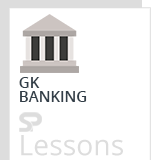 Introduction
Introduction
The article Important Banking Interview Questions provides important interview questions and answers for some bank related exams like IBPS SO, IBPS PO, IBPS Clerk, etc. The article Important Banking Interview Questions can help the aspirants to face the interview with proper knowledge. After clearing the written exams, some aspirants were not able to perform well at the time of interview. Due to the insufficient knowledge of interview session or some fear the aspirants were not able to give their best in the interview sessions. So, the main aim of the article Important Banking Interview Questions is to provide some awareness about the interview questions.
 History
History
Important Banking Interview Questions: History
Managing an account in India has a long history beginning from the late 18th century. The root of present day saving money began from 1770 for the sake of "Bank of Hindustan" by English office 'Place of Alexander and Co' in Kolkata anyway it was shut in 1832. Further in 1786 "General Bank of India" was begun and it flopped in 1791.
Important Banking Interview Questions: Presidency Banks
These banks were funded by the presidency government at that time.
The 3 presidency banks were
- Bank of Bengal- Established in 1806
- Bank of Bombay - Established in 1840
- Bank of Madras - Established in 1843
 Interview
Interview
Important Banking Interview Questions: Bank Interview
Interviews are the last obstacles in the selection process of almost all major banking exams that all aspirants must cross to land their dream jobs. Interviews can be extremely scary to a few people.
Interviews for banking and finance positions are notoriously tough. Interviewers can expect all the questions from a normal job interview, along with the potential for extremely difficult questions, relating specifically to both financial services and to hypothetical scenarios.
1. International Gold Price
The Current Gold Price in International Market is $37,035.73/kg or in Rupees –Rs 2519077.77
2. What is RTGS?
RTGS stands for real time gross settlement, which means that it enables money to move from one bank to another on a real time and gross basis. Simply put, real time means the beneficiary bank receives the instructions for fund transfer immediately and gross means that it is not bunched with any other transaction and settlements of funds transfer instructions happen individually. Since the funds settlement takes place in the books of the Reserve Bank of India (RBI), keep in mind that the payments are final and irrevocable.
3. What is NEFT?
Neft stands for National Electronic Funds Transfer and is a payment system which facilitates one-to-one funds transfer. Like RTGS, Neft also transfers funds from one bank, but unlike RTGS the settlement takes place in batches (that may include transfers from various individuals) rather than individually. The batches are settled in hourly time slots.
4. How is RTGS different from NEFT?
Timing : As mentioned above, Neft operates in hourly batches. Currently, it has 11 settlements from 9am to 7pm on weekdays and five settlements from 9am to 1pm on Saturdays. So, in case you initiate a transaction after a settlement time you have no option but to wait till the next settlement time. But that’s not the case with RTGS transactions, since they are processed constantly throughout the RTGS business hours.
The service window for RTGS at banks is available from 9am to 4.30pm on week days and from 9am to 1.30pm on Saturdays for settlement at the RBI end. Keep in mind that the timings that each bank follows may vary.
Amount : As far as Neft goes, it does not have a minimum or maximum limit of amount you can transfer. But the maximum amount per transaction is limited to Rs 50,000 for cash-based remittance and remittance to Nepal.
As far as RTGS goes, it is mostly meant for large transactions. The minimum amount that can be remitted through it is Rs 2 lakh. RTGS does not have an upper ceiling for transactions.
Charges : For Neft, inward transactions (when you receive funds via Neft) are free, as no charges are to be levied from the person to whom fund are being transferred to. When you use Neft to make an outward transaction (when you send funds via Neft) at a bank branch for amounts up to Rs 1 lakh, the charge is up to Rs 5 plus service tax. For transactions above Rs 1 lakh and up to Rs 2 lakh, the charge is up to Rs 15 plus service tax. for transactions above Rs 2 lakh, the charges can’t exceed Rs 25 plus service tax. For RTGS, inward transactions (when you receive funds through RTGS) are free. For outward transactions (when you send funds via RTGS), if the amount is between Rs 2 lakh and Rs 5 lakh, the charges will be up to Rs 30 per transaction. If the amount transferred is above Rs 5 lakh, the charges can’t exceed Rs 55 per transaction.
5. What is Golden Slam?
A player who wins all four Grand Slam tournaments and the Olympic gold medal during his or her career is said to have achieved a Career Golden Slam. Serena Williams is the only player to have achieved a career golden slam in both singles and doubles.
6. What is the 'Quick Ratio'?
The quick ratio is an indicator of a company’s short-term liquidity. The quick ratio measures a company’s ability to meet its short-term obligations with its most liquid assets. For this reason, the ratio excludes inventories from current assets, and is calculated as follows:
Quick ratio = (current assets – inventories) / current liabilities or
= (cash and equivalents + marketable securities + accounts receivable) / current liabilities
The quick ratio measures the dollar amount of liquid assets available for each dollar of current liabilities. Thus, a quick ratio of 1.5 means that a company has $1.50 of liquid assets available to cover each $1 of current liabilities. The higher the quick ratio, the better the company's liquidity position. Also known as the “acid-test ratio" or "quick assets ratio."
7. Difference between Nationalized banks & Private bank?
Nationalized banks
10. What is Financial Inclusion?
Rangarajan committee (2008)1 defined financial inclusion as, "the process of ensuring access to financial services and timely and adequate credit where needed by vulnerable groups such as weaker sections and low income groups at an affordable cost."
- A public sector bank is a bank in which the government holds a major portion of the shares.
- Government holdings are more than 50% in public sector banks.
- Private sector banks are owned by private lenders.
- The private banks are managed and controlled by private promoters.
| Liabilities | Assets |
|---|---|
| a. Share Capital | a.
|
| b. Reserve Funds | b. Loans & Advances Given |
c. Deposits
|
c. Investment of banks |
| d. Borrowing | |
| e. other Liabilities | e. Other Assets |
11. Role of banks in Financial Inclusion programme-
Given the evidence that financial access varies widely around the world, and that expanding access remains an important challenge even in advanced economies, it is clear that there is much for policy to do. The need for coordination on collective action, and concentrations of poor people, mean that banks in India everywhere have an extensive role in supporting, regulating, and sometimes directly intervening in the provision of financial services.
The role of commercial banks to be performed as part of financial inclusion programme:
a) Financial literacy - Providing financial literacy is the core function of financial inclusion, as the main reason for exclusion is the lack knowledge about formal financial system. Financial literacy refers to knowledge required for managing personal finance. The ultimate goal is empowerment of people to take action by them that are in their self interest.
b) Credit counseling - There are two types of credit counseling, one is preventive counseling and the other is curative credit counseling.
Preventive counseling will include bringing awareness regarding cost of credit, availability of backward and forward linkages, etc., need to avail of credit on the basis of customer’s repaying capacity.
In case of curative counseling the credit counseling center will work out individual debt management plans for resolving the unmanageable debt portfolio of the clients by working out effective debt restructuring plan in consultation with branch of the bank, taking into account income level and size of the loans.
c) BC/BF model - With an effort to focus commercial banks, to reach rural household and farm household, banks were permitted to use infrastructure of civil society organizations, rural kiosks, and adopt Business Facilitator (BF) and Business Correspondent (BC) models for providing financial services.
d) KYC norms - In order to ensure that persons belonging to the low income group both rural and urban areas do not encounter difficulties in opening bank accounts, the Know Your Customer procedure (KYC) for opening bank account was simplified asking banks to seek only a photograph of the account holder and self certification of addresses (the amount of outstanding balance in these accounts would be limited to 50000 rupees and total transactions would be limited to one lakh rupees in one year.
e) KCC/GCC Banks were asked to introduce a general credit card (GCC) scheme for issuing GCC to their constituents in rural and semi-urban areas based on the assessment of income and cash flow of the household similar to that prevailing under normal credit card without insisting on security and the purpose or end use of credit (as Point Of Sale-POS and ATM facilities) with similar products are not feasible or available and limited infra structure in rural areas. The limit under GCC is up to 25000 rupees. Banks were advised to utilize the services of Schools, health,etc.
f) No-frill accounts Financial literacy - In November 2005 RBI advised banks to make available a basic banking “No-frill Account” with low or nil minimum balances as well as charges to expand the outreach of such accounts to vast sections of the population.
g) Branch expansion
Mobile banking is a term used for performing accounting transactions, balance checks, payments via mobile device such as mobile phone.mobile banking enables:
14. Difference between NBFC & Bank?
15. What is MCLR?
The Reserve Bank of India has brought a new methodology of setting lending rate by commercial banks under the name Marginal Cost of Funds based Lending Rate (MCLR). It has modified the existing base rate system from April 2016 onwards. – As per the new guidelines by the RBI, banks have to prepare Marginal Cost of Funds based Lending Rate (MCLR) which will be the internal benchmark lending rates. Banks have to set five benchmark rates for different tenure or time periods ranging from overnight (one day) rates to one year.
16. Why the MCLR reform?
At present, the banks are slightly slow to change their interest rate in accordance with repo rate change by the RBI. Commercial banks are significantly depending upon the RBI’s LAF repo to get short term funds. But they are reluctant to change their individual lending rates and deposit rates with periodic changes in repo rate. Whenever the RBI is changing the repo rate, it was verbally compelling banks to make changes in their lending rate. The purpose of changing the repo is realized only if the banks are changing their individual lending and deposit rates.
17. How to calculate MCLR?
In economics sense, marginal means the additional or changed situation. While calculating the lending rate, banks have to consider the changed cost conditions or the marginal cost conditions. For banks the cost for obtaining funds is basically the interest rate given to the RBI for getting short term funds.
Following are the main components of MCLR.
- a) Users to perform banking transaction using mobile phone like balance checks, fund transfers, bill payment etc.
b) Purchase goods over internet or phone delivery
c) Person to person fund transfers
d) To pay goods at merchant location point of sale.
| Cheque | Demand Draft |
|---|---|
| Cheque is issued by customer | Demand draft is issued by the bank. |
| In cheque payment is made after presenting cheque to bank | DD is given after making payment to bank. |
| Cheque can bounce due to insufficient balance | DD cannot be dishonored as amount is paid before hand. |
| Payment of cheque can be stopped by drawee | Payment cannot be stopped in DD. |
| In cheque drawer and payee are different person. | In DD, both parties are banks. |
| A cheque needs signature to transfer amount | DD does not require signature to transfer funds |
| Basic For Comparison | NBFC | Bank |
|---|---|---|
| Meaning | An NBFC is a company that provides banking service to people without holding a bank license | Bank is a government authorized financial intermediary that aims at providing banking services to the general public. |
| Incorporated under | Companies Act 1956 | Banking Regulation Act, 1949 |
| Demand Deposits | Not Accepted | Accepted |
| Foreign Investment | Allowed up to 100% | Allowed up to 74% for Private Sector Banks. |
| Payment and Settlement system | Not a part of system. | Integral part of the system. |
| Maintenance of Reserve Ratio | Not Required | Compulsory |
| Deposits Insurance Facility | Not Available | Available |
- Marginal cost of funds
- Negative carry on account of CRR
- Operating costs
- Tenor premium
- Cost for the funds (interest rate given for deposits)
- Operating expenses
- Minimum rate of return (profit), and Cost for the CRR (for the four percent CRR, the RBI is not giving any interest to the banks)
- Marginal cost of funds
- Negative carry on account of CRR
- Operating costs
- Tenor premium
- The marginal costs include Repo rate; whereas this was not included under the base rate.
- Many other interest rates usually incurred by banks when mobilizing funds also to be carefully considered by banks when calculating the costs.
- The MCLR should be revised monthly.
- A tenor premium or higher interest rate for long term loans should be included.



